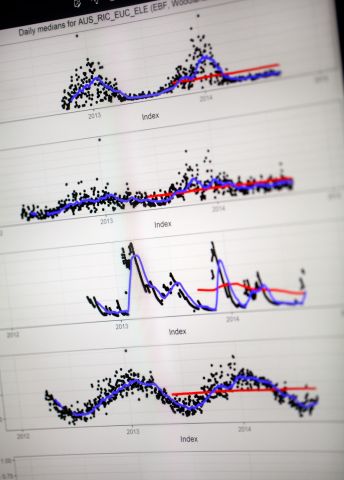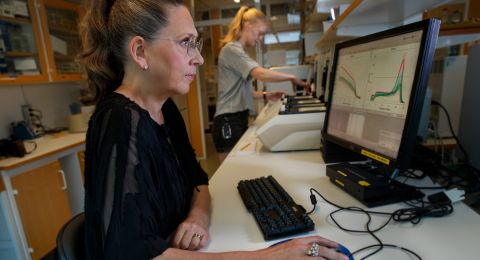
Project Grant 2022
Feedback between a changing climate and vegetation
Principal investigator:
Ilona Riipinen, Professor of Atmospheric Sciences
Co-investigators:
Stockholm University
Annica Ekman
Radovan Krejci
Paul Zieger
Institution:
Stockholm University
Grant in SEK:
SEK 31.1 million over five years
Clouds are gathering in the skies above the Geosciences building at Stockholm University. Rain is in the air, ironically enough, for inside the building the researchers are examining processes impacting cloud formation – a key factor in climate.
Cloud formation is affected by plants on the Earth’s surface. Green plants absorb carbon dioxide – a greenhouse gas – from the atmosphere, but they also impact the climate in another, less studied, way.
Forest impacting clouds
Plants release carbon-based molecules in the form of VOCs – volatile organic compounds. The scent of pine on a warm day in the forest comes from molecules of this kind.
“Plants use these compounds to defend themselves against insects and to communicate. But we’re interested in them because they serve as building blocks for clouds and are therefore important from a climate viewpoint,” says Ilona Riipinen, who is heading the project and is Professor of Atmospheric Sciences at Stockholm University.
Clouds play a key role in temperature on Earth. They can reflect the sun’s rays so they do not reach the Earth’s surface, and prevent heat from escaping into space.
When VOC molecules released by plants reach the atmosphere, they readily react with oxidants, forming minute airborne particles – aerosols. Aerosols may be described as cloud seeds: they determine the number of cloud droplets formed as well as how light or dark clouds are. This in turn determines how well clouds reflect light from the sun.
“Even fairly small changes in the reflective ability of clouds can have a major impact on the energy balance and climate. Plant VOC emissions and aerosol concentrations in the air play an important part, but there are still many uncertainties,” says Riipinen, and elaborates:
“To find out exactly how many degrees we can expect the temperature on Earth to rise due to a given increase in carbon dioxide emissions, we need to know more about how clouds and aerosol particles are formed and impacted. This is one of the aims of our project.”
Riipinen points out that current climate models are based on rough approximations of VOC emissions and aerosol formation, if these factors are even included. The project aims to change that. The team includes theoretical and experimental researchers, working together to examine the entire chain, from VOC emissions, via aerosol and cloud formation to climate impact.
Sampling the air in coniferous forest
In the lab Riipinen presents a measuring instrument that lies at the heart of the project’s experimental component – a mass spectrometer. It is heavy, but not too heavy to use in the field. It enables the scientists to separate molecules in an air sample according to weight, and to ascertain which particles, and how many of them, the air contains.
“These measurements are technically challenging. Our team’s strength is that we can combine theoretical and large-scale climate know-how with experimental expertise.”
Among other things, the researchers will measure and characterize VOC emissions at field stations in tropical forests in Brazil and Panama, and in coniferous forest in Sweden, which form part of the boreal forest ecosystem extending across the northern hemisphere.
“These are the two most extensive types of forest on Earth. But it is also of scientific interest to compare them: they form different kinds of VOCs, and processes are more dynamic and faster in tropical forests.”
The team will also be taking measurements in conjunction with felling of forest in Sweden.
Tests on tropical plants
A key element of the practical work is being carried out in experimental glasshouses in Panama. There the researchers can expose tropical forest plants to elevated carbon dioxide concentrations and temperatures, and then ascertain which particles the plants release. The results may provide a glimpse of the future: they show how VOC emissions change as the climate warms and the amount of carbon dioxide in the air rises.
“In Panama we can also use controlled experiments to test the accuracy of VOC emission estimates in current climate models.”
The researchers will also be taking air samples from the experimental glasshouses, adding oxidants to them and measuring the formation of aerosol particles.
Long measurement series
The researchers often use existing research infrastructure, such as the glasshouses in Panama, and use their measurement methods in that context. They also benefit from existing measurement networks, such as ACTRIS, which makes standardized measurements of aerosol particles and clouds at monitoring stations around Europe.
On a computer screen Riipinen shows diagrams illustrating how fluid flow in trees in different types of forest is impacted by moisture in the soil and air where the trees grow. The diagrams are based on readily available data obtained over long periods – an important source of information for the project.
“The data provide both inspiration and a context for our own, more specific, experiments. We’re trying to see how fluid flow in trees is linked to their VOC emissions.”
Riipinen hopes the project will contribute to a better understanding of water and carbon cycles in forest environments, and their role in relation to climate. The experimental data the researchers are gathering is being used to design better theoretical descriptions, which can then be used in global climate models.
“I hope we can help to improve the ability of climate models to predict clouds and precipitation. This is vital in terms of the implications for life on Earth,” Riipinen says.
Text Sara Nilsson
Translation Maxwell Arding
Photo Magnus Bergström





